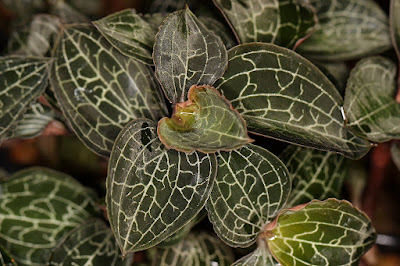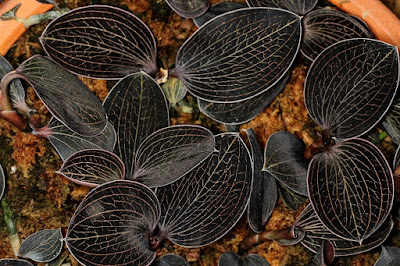Anoectochilus - Marbled Jewel orchid is characterized by beautiful, soft, velvety foliage decorated with a network of white, pinkish, or golden veins.
Anoectochilus, also called as Marbled Jewel orchid, Anectochilus, Chrysobaphus, is a genus in the Orchidaceae family. This genus was described by Carl Ludwig Blume in 1825 with Anoectochilus setaceus as the type species.
DESCRIPTION OF ANOECTOCHILUS - MARBLED JEWEL ORCHID
Anoectochilus is native to Tropical and Subtropical Asia to Pacific. It is found growing in bogs and near rivulets in deep shade in Andaman Is., Assam, Bangladesh, Borneo, China South-Central, China Southeast, East Himalaya, Fiji, Hainan, Hawaii, India, Jawa, Laos, Malaya, Maluku, Myanmar, Nansei-shoto, Nepal, New Caledonia, New Guinea, Nicobar Is., Queensland, Samoa, Santa Cruz Is., Solomon Is., Sri Lanka, Sulawesi, Sumatera, Taiwan, Thailand, Tibet, Vanuatu, Vietnam, West Himalaya.
The species of this genus are terrestrials or occasionally as lithophytes with creeping, terete, several noded, fleshy rhizome. The stems are short, soft, fleshy, succulent, brownish, erect or ascending, with 1 to a few loose tubular sheaths at base. They are characterized by beautiful, soft, velvety leaves that are arranged in rosette near the apex of the stem. The leaves are green to purplish black with white, pinkish, or golden reticulate venation, ovate or elliptic, with a long petiole-like base dilating into tubular sheath.
Marbled Jewel orchid blooms from the erect, terminal, racemose, pubescent, few flowered inflorescences with persistent floral bracts. The flowers are relatively large, hairy, velvety, resupinate or not. The dorsal sepal and petals overlap to form a hood over the column with the lateral sepals spreading apart from each other. The labellum is relatively large with epichile and hypochile separated by a narrow section. The hypochile has a cylinder-shaped spur containing two large glands and is joined to the epichile with a claw that has spreading teeth or a long fringe.
ANOECTOCHILUS - MARBLED JEWEL ORCHID CARE AND CULTURE
Cultural information should only be used as a guide, and should be to be adapted to suit you. Your physical location; where you grow your plants, how much time you have to devote to their care, and many other factors, will need to be taken into account. Only then can you decide on the cultural methods that best suit you and your plants.
Light:
Anoectochilus needs a light level of 8000-18000 lux. The light should be well filtered and dispersed, and the plants should not be exposed to direct sunlight. Strong air movement should be ensured all the time.
Temperature:
Most species of this genus can grow in intermediate to warm temperature. In summer, the average day temperature is 27-29 °C, the night 21-22 °C, which gives a daily difference of 6-7 °C. In winter, the average day temperature is 26-28 ° C, at night 18-19 °C, with a daily amplitude of 8-10° C.
Humidity:
Marbled Jewel orchid needs the humidity of 80-90% throughout the year. Too dry air has a negative effect on the development of the plant: its growth is inhibited, and the leaves begin to turn yellow and dry out. The higher temperature, the higher the humidity should be, and the higher the humidity, the more often and longer it is necessary to ventilate the room where the plants are contained, otherwise the probability of rotting and various kinds of fungal diseases. Good air movement is essential while the plants are in leaf and growing.
Substrate, growing media and repotting:
Anoectochilus are usually grown in shallow pots with good drainage, filled with a very loose, quickly drying ground, such as medium granulation bark or chopped tree fern fibers. Also, materials that loosen the substrate but often retain a portion of the moisture, e.g. perlite and cut sphagnum moss, are often added to such a mixture. Wood charcoal is also often added to ensure the air permeability of the substrate and protection against acidification.
The plants should be repotted when the substrate begins to decompose or grow out of the pots. If repotting is done at the time when new roots begin to appear, the plant will be accepted and rooted in the shortest possible time. These plants relatively easily reproduce from pieces of stem.
Watering:
Marbled Jewel orchid in the phase of active growth should be frequently watered, but they should slightly dry out between waterings and you can never allow the substrate around the roots to be stale or soaked. When new growths reach maturity in the autumn, the amount of water should be gradually reduced.
Fertilizer:
During the active growth, the plants should be fertilized every week 1/4-1/2 of the recommended dose of fertilizer for orchids. You can use balanced fertilizer throughout the year, but can also use fertilizer with increased nitrogen content from spring to mid summer, and then in the late summer and autumn, use a fertilizer with a higher content of phosphorus.
Rest period:
Anoectochilus does not need a rest period to stimulate flowering, but in winter watering should be limited, especially those grown in colder conditions, but it is not allowed to dry excessively or remain dry for a long time. Fertilization should be reduced or completely eliminated until more intense watering starts in the spring.















COMMENTS